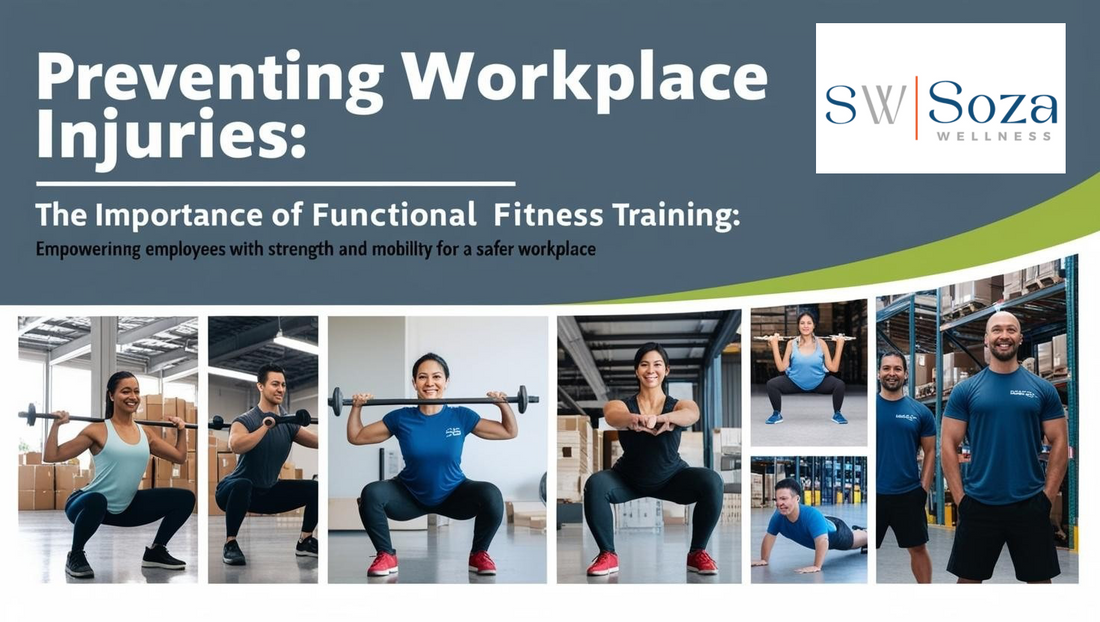
Preventing Workplace Injuries: The Importance of Functional Fitness Training
Share
Workplace injuries are a significant concern for both employees and employers. Whether caused by heavy lifting, repetitive motions, or long hours at a desk, these injuries can impact productivity, morale, and overall employee health. Functional fitness training offers a proactive solution, equipping employees with the strength and mobility needed to perform daily tasks safely.
In this blog, we explore the importance of functional fitness training and how it helps prevent workplace injuries while promoting employee wellbeing.
What Is Functional Fitness Training?
Functional fitness focuses on exercises that mimic everyday movements, strengthening the muscles needed for daily activities. Unlike traditional strength training, which isolates specific muscle groups, functional fitness engages multiple muscles and joints simultaneously to improve balance, flexibility, and coordination.
Examples of functional fitness exercises include:
• Squats: Mimicking the movement of sitting and standing.
• Deadlifts: Building strength for lifting objects safely.
• Planks: Enhancing core stability for better posture.
• Lunges: Improving balance and lower-body strength.
By training your body for real-life activities, functional fitness reduces the risk of injuries caused by improper movement or muscle imbalances.
Common Workplace Injuries Functional Fitness Addresses
Functional fitness training targets the root causes of many workplace injuries, including:
• Back Strain: Caused by improper lifting techniques or prolonged sitting.
• Repetitive Motion Injuries: Resulting from tasks like typing, assembly line work, or repetitive lifting.
• Poor Posture-Related Injuries: Stemming from extended periods of sitting or standing without adequate support.
• Muscle Weakness and Imbalances: Leading to joint pain or mobility issues.
Functional exercises strengthen the muscles and joints needed for workplace tasks, improving employee health and reducing injury risks.
Benefits of Functional Fitness Training in the Workplace
Investing in functional fitness training offers significant advantages for both employees and employers:
1. Injury Prevention
Functional fitness teaches proper body mechanics and strengthens the muscles used in everyday movements. Employees learn how to lift, bend, and reach safely, reducing the likelihood of strains, sprains, and overuse injuries.
2. Improved Employee Health
Functional fitness promotes overall wellbeing by improving strength, flexibility, and endurance. Healthier employees are less likely to experience chronic pain or illness, leading to fewer sick days.
3. Increased Productivity
When employees are free from pain and injury, they can perform tasks more efficiently and with greater focus. Functional fitness enhances physical performance, directly impacting workplace productivity.
4. Enhanced Morale and Retention
Providing fitness training demonstrates an employer’s commitment to employee health and safety. This fosters a positive work culture, boosting morale and retention rates.
Implementing Functional Fitness Training in the Workplace
Incorporating functional fitness into the workplace doesn’t have to be complicated. Follow these steps to get started:
1. Assess Workplace Needs:
Identify common tasks and injury risks specific to your workplace. For example, warehouse workers may benefit from lifting exercises, while desk workers may need posture-focused routines.
2. Partner with Experts:
Collaborate with organizations like Soza Wellness to design and implement customized fitness programs that address employee needs.
3. Offer On-Site or Virtual Training:
Provide accessible options for employees to participate in functional fitness sessions, whether on-site or through virtual platforms.
4. Encourage Consistency:
Promote regular participation by scheduling short, frequent training sessions. This makes fitness achievable even for busy employees.
5. Monitor Progress:
Track participation rates and gather feedback to continuously improve the program and demonstrate its value to employees.
Real-World Success with Functional Fitness
Organizations that integrate functional fitness into their wellness programs report significant results:
• A reduction in workplace injuries by up to 50%.
• Improved employee morale and job satisfaction.
• Enhanced physical and mental wellbeing, leading to higher productivity.
For example, companies that partnered with Soza Wellness have seen measurable improvements in employee performance and a decline in injury-related absences.
How Soza Wellness Can Help
At Soza Wellness, we specialize in designing functional fitness programs tailored to your organization’s needs. Our services include:
• Custom Training Plans: Focused on reducing injury risks and enhancing strength and mobility.
• On-Site and Virtual Options: Ensuring accessibility for all employees.
• Expert Guidance: Delivered by experienced trainers who understand workplace challenges.
Our holistic approach to workplace wellness helps employees achieve better health while improving overall organizational performance.
Conclusion: Building a Safer Workplace with Functional Fitness
Preventing workplace injuries requires more than just safety protocols—it demands proactive solutions that empower employees to move with strength and confidence. Functional fitness training is a powerful tool for fostering a safer, healthier work environment. By prioritizing employee wellbeing, organizations can reduce injuries, boost morale, and improve productivity.
Ready to implement functional fitness training in your workplace? Contact Soza Wellness to create a customized program that meets your team’s needs and builds a foundation for sustainable health. Let’s work together to create a safer, more productive workplace.
Experience holistic wellness and self-discovery with the Love, Be Well, and Travel Program, where mindfulness meets adventure—learn more here! 🌿✈️
